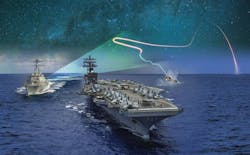Navy asks Northrop Grumman surface warfare experts to build electronic warfare (EW) for ship missile defense
WASHINGTON – U.S. Navy surface warfare experts are ordering advanced electronic warfare (EW) systems for aircraft carriers and amphibious assault ships under terms of a $100.8 million contract announced Friday.
Officials of the Naval Sea Systems Command in Washington are asking engineers at the Northrop Grumman Corp. Mission Systems segment in Linthicum Heights, Md., to build the Surface Electronic Warfare Improvement Program (SEWIP) Block 3 electronic attack systems and hardware design modifications for aircraft carriers and amphibious assault ships.
SEWIP is an evolutionary acquisition program to upgrade the existing out-of-production AN/SLQ-32(V) shipboard EW system and provide improved anti-ship missile defense and situational awareness.
Northrop Grumman won $267 million Navy contract in 2015 to develop and build SEWIP Block 3 to make further upgrades to the AN/SLQ-32 with new technologies for early detection, signal analysis, threat warning, and protection from anti-ship missiles. There are three established SEWIP block upgrades and a fourth is planned.
The Lockheed Martin Rotary and Mission Systems segment in Liverpool, N.Y., is building the SEWIP Block 2 surface warfare EW system, which provides improved electronic support receivers and combat system interface and expands the receiver and antenna group to help surface electronic warfare capabilities keep pace with growing threats.
Since the SEWIP program started in 2002, General Dynamics Advanced Information Systems (AIS) in Fairfax, Va., acted as prime contractor for SEWIP blocks 1A, 1B1, 1B2, and 1B3.
Developed by Raytheon in the 1970s, the original AN/SLQ-32 systems employed passive radar technology for early warning, identification and tracking of enemy threats. Subsequent upgrades provided an additional active capability for simultaneous jamming of several different threats.
On this contract Northrop Grumman will do the work in Baltimore and White Marsh, Md.; Tampa, Fla.; Andover and Chelmsford, Mass.; Rochester, N.Y.; San Diego, El Cajon, Los Angeles, and Glendale, Calif.; Winona and Minneapolis, Minn; Stafford Springs, Conn; Glendale, Ariz.; Nashua, N.H.; Elk Grove Village and Woodridge, Ill.; Tucson and Chandler, Ariz.; Washington, N.C.; Richardson, Texas; Hiawatha, Iowa; Littleton, Colo., and other U.S. locations, and should be finished by May 2023.
For more information contact Northrop Grumman Mission Systems online at www.northropgrumman.com.

John Keller | Editor-in-Chief
John Keller is the Editor-in-Chief, Military & Aerospace Electronics Magazine--provides extensive coverage and analysis of enabling electronics and optoelectronic technologies in military, space and commercial aviation applications. John has been a member of the Military & Aerospace Electronics staff since 1989 and chief editor since 1995.

